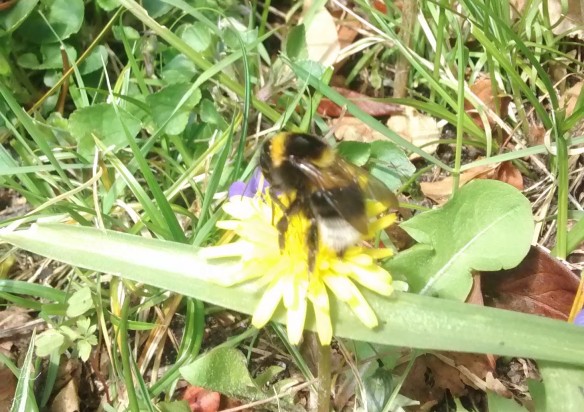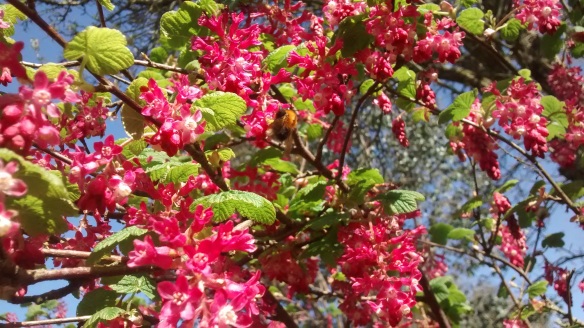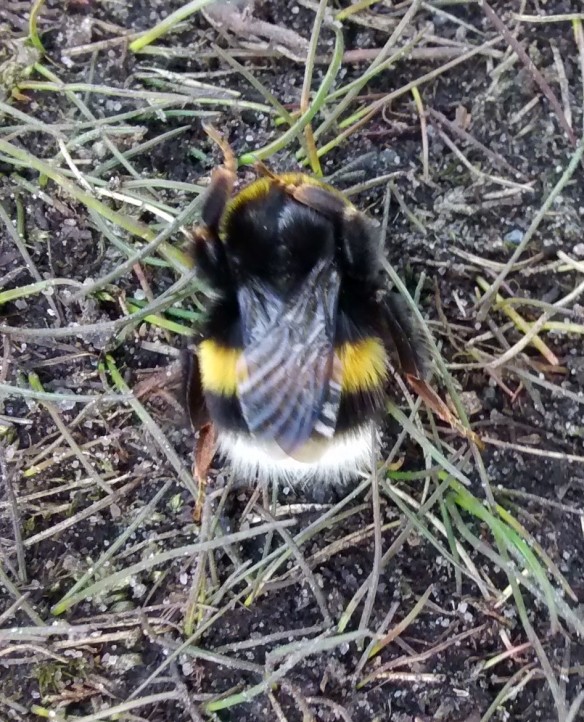Maybe you’ve noticed the spring arrival of huge queen bumblebees? From March onwards they begin to emerge from hibernation and begin the search for a nesting spot. You’ll see them buzzing along near the ground or along walls, stopping every so often to investigate a likely looking hole or crevice. More often than not it’s found wanting as a nest site and out she comes a few moments later to try somewhere else.

Buff-tailed bumblebee Bombus terrestris (Photo credit: Tom Wood)
There are 24 species of bumblebee in the UK but only 8 of these are widely distributed. 6 of these are pictured here although the photo quality is very variable! The biggest threat to bumblebees is habitat loss due to changes in agricultural practices in the UK. Since the 1930s 97% of flower-rich grassland in the UK has been replaced with arable crops or grazing land. Bumblebees are entirely dependent on the pollen and nectar provided by flowers so this has been a huge blow.

Common carder bee Bombus pascuorum
Back in February, I attended a talk at the university by Dr Catherine Jones, a visiting research fellow who is heavily involved with the Bumblebee Conservation Trust and the reintroduction of the Short-Haired bumblebee in Kent. She explained the importance of monitoring and introduced the Beewalk. This is a citizen science project using a transect method to quantitatively surveying for bumblebees. The idea is that you set up your transect of 1-2 km and walk the route every month from March to October, identifying and counting the bumblebees you see on the route.

Garden bumblebee Bombus hortorum
More recently I attended a training event as part of the survey volunteer group at Marsden Moor NT. This was run by Moors for the Future and intended to train volunteers to survey bumblebee transects in the Peak District and South Pennines. In order to collect robust and comparable data they have set up a number of transects following Beewalk methodology. However, to simplify the data collection process, the Moors for the Future survey focuses on 3 key species. These are species which are particularly expected to change in distribution in the Peak District area in the future so are of great interest to help monitor these changes. The Bilberry bumblebee is an upland species, which is found in colder climates and expected to decline in the Peak District in response to climate change. The Tree bumblebee is a newcomer, first seen in the UK in 2001 and spreading rapidly northwards so expected to increase in abundance and distribution in the Peak District. The Red-tailed bumblebee is common across the UK but expected to become more common in the colder uplands in response to climate change.

Tree bumblebee Bombus hypnorum
Following all this bumblebee talk, I’ve decided to set up my own Beewalk transect to survey for bumblebees in Leeds. I’m starting a little late but hopefully I’ll get some good results and improve my bumblebee ID skills. After a chat with a representative from Butterfly Conservation Yorkshire, I’m hoping I can combine the same route with a butterfly transect this summer and learn more about these beautiful insects too.
More on these to come then!

Early bumblebee Bombus pratorum

White-tailed bumblebee Bombus lucorum

It had never actually occurred to me that there were different species of bumblebee in the UK, I don’t think I’ve ever had a long enough look at them to tell them apart =/
LikeLike
Max, what a wonderful project to become involved with. Perhaps your example will lead others to join you. I look forward to reading more about you and the bumblebees. 🙂
LikeLike